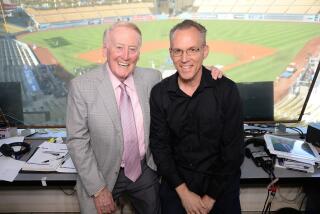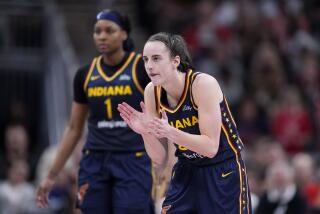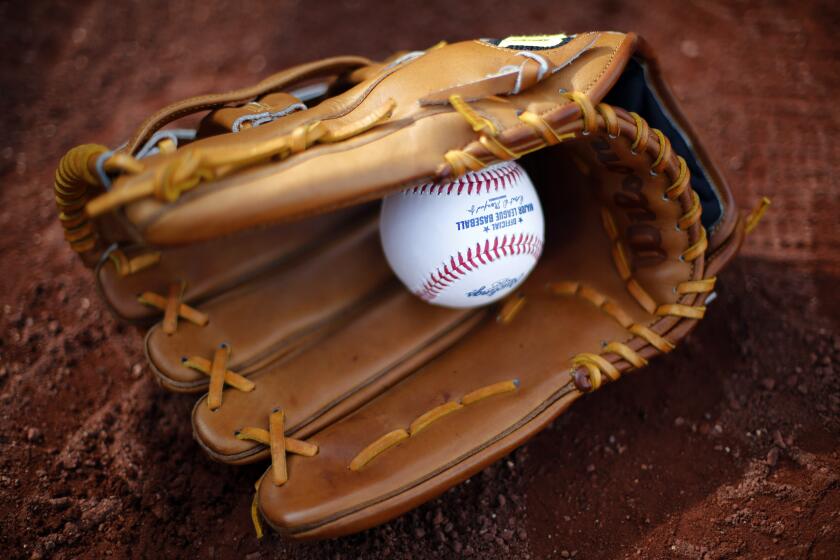Century of Triumph, Tragedy
- Share via
SPOKANE, Wash. — The Spokane Indians have known tragedy and greatness, scoundrels and Hall of Famers. They’ve finished first and last, and even left town.
Now, as they celebrate a century of baseball, the Indians are owned by George Brett and three of his brothers, and are perhaps the premier franchise in the Northwest League.
“I enjoy going to a minor league park more than I do going to a major league stadium,” Brett says in a new video “Spokane Indians, a Century of Baseball,” produced for the centennial.
The team’s history has been compiled by Jim Price, a former Indian radio broadcaster and now a sportswriter for The Spokesman-Review newspaper.
A minor league team known as the Spokanes began play in 1901. In 1903 The Spokesman-Review held a contest for a new name. The winning entry was the Inlanders, a name that was used for about two weeks, Price said.
But the May 11, 1903, edition of the newspaper referred to the team as the Indians, for no apparent reason.
“There was no explanation and there never has been an explanation,” said Price, who is finishing a book on the team. The name stuck, and that’s the date marked by this year’s centennial.
In reality, the Indians have played for only 85 seasons, with various closures during wartime or because of financial problems.
The 1913 team featured pitcher Stan Coveleski, who won three games for Cleveland in the 1920 World Series and made the Hall of Fame.
But that team also featured Swede Risberg and Shufflin’ Bill Douglas, two of the most infamous figures in baseball history.
Risberg was one of eight members of the Chicago White Sox charged with fixing the 1919 World Series in the “Black Sox” scandal. The shortstop was banned for life from baseball after the 1920 season.
Douglas posted a 93-93 record in nine seasons in the major leagues before he was banned for life for offering to take a bribe.
“Only about a dozen players have been thrown out of baseball for life, and two played in Spokane in the same year,” Price noted.
The 1914 team featured Hall of Famer George Kelly and future Yankee star Bob Meusel.
Financial problems caught up with the Indians and there was no minor league baseball in Spokane for much of the 1920s and the early ‘30s.
Baseball returned in 1937, and the Indians became one of the nation’s top-drawing teams, with more than 200,000 fans in 1939, 1940 and 1941.
Minor league baseball was suspended in 1942 because of World War II, and the Indians returned to the field in 1946.
On June 24 of that year, the team climbed onto a chartered bus for Bremerton, 300 miles west over the Cascade Range.
Coming down the west side of Snoqualmie Pass around 8 p.m. in a light drizzle, driver Glen Berg saw an oncoming car cross the centerline on the two-lane road and moved his bus to the right.
The rear wheels went off the road, Berg lost control, and the bus tore out 125 feet of guardrail before plunging 300 feet down a steep grade. It flipped several times, hit a boulder, and rolled. Some players were thrown out, while others stayed inside and were burned when the gas tank exploded.
Nine were killed: player-manager Mel Cole, Fred Martinez, Bob James, Bob Kinnaman, Bob Paterson, George Risk, George Lyden, former major leaguer Chris Hartje and Vic Picetti.
“With nine deaths, more than 50 years later, that is still the worst accident involving an American pro sports team,” Price said
Infielder Jack Lohrke was on the bus at the beginning of the trip, but learned during the dinner stop in Ellensburg that he had been called up by San Diego of the Pacific Coast League. He immediately left to hitchhike south, missing the crash. During his seven seasons in the majors, he was known as Lucky Lohrke.
To field a team, the Indians scoured area ballparks for recruits and accepted players from other clubs. They resumed play on July 4, 1946, and by 1948, the franchise had recovered enough to win a league title.
The rise of television hurt minor league attendance, and Spokane was not immune. Looking to boost ticket sales, the 1951 team played home games in shorts.
During the 1955 and 1956 seasons, the Indians were owned by people who bought $10 shares in the team. That ownership plan failed, and there was no team in 1957.
In 1958, the Brooklyn Dodgers moved to Los Angeles, displacing the Angels of the Pacific Coast League. That team moved to Spokane as the Indians, playing in a new $500,000 stadium and kicking off 22 seasons of Triple-A baseball in the city. Maury Wills scored the first run in what is now Avista Stadium.
In 1960, the Indians won the PCL title, with Ron Fairly hitting 27 homers.
“We averaged seven runs a game and that’s hard to beat,” recalled Fairly, now an announcer for Seattle.
Peter O’Malley became general manager in 1965, and Tommy Lasorda became the manager in 1969, setting the stage for greatness.
The 1970 squad featured future major leaguers Steve Garvey, Bill Buckner, Bobby Valentine, Davey Lopes, Bill Russell, Tom Paciorek, Doyle Alexander, Geoff Zahn and Charlie Hough. They won their division by 26 games and swept the Hawaii Islanders to win the PCL championship.
Baseball America called it the best minor league team of the second half of the 20th century.
“The other teams hated us, no doubt about it,” Valentine, who led the PCL in hitting, told the documentary makers. “Tommy was louder than any other manager, and we were better than any other team.”
In 1971, Washington State star Ron Cey played for the Indians. He, Russell, Lopes and Garvey would form the longest-lasting infield combination in major league history, more than eight seasons with the Dodgers.
But attendance was disappointing, and the Dodgers moved the team to Albuquerque after the 1971 season.
The Portland Beavers moved to Spokane and took the Indians’ name in 1973 as a Triple-A affiliate of Texas, California, Milwaukee and Seattle. The franchise then moved to Las Vegas, replaced by a Northwest League team in 1982.
The Brett brothers -- George, Ken, Bobby and John -- bought the Indians in 1985. George Brett became the seventh Hall of Famer associated with the Indians, joining Coveleski, Kelly, Duke Snider, Hoyt Wilhelm, Don Sutton and Lasorda.
With Bobby as managing partner, the Bretts promoted heavily, won several championships, and have generally led the league in attendance by averaging more than 4,000 fans per game.
Their simple formula, according to Bobby Brett, is: “A $1 hot dog, free to park, $3 for kids to come to the game.”
In the first year of a new affiliation with Texas, the Indians open the 2003 season June 21 against the Everett AquaSox.
More to Read
Go beyond the scoreboard
Get the latest on L.A.'s teams in the daily Sports Report newsletter.
You may occasionally receive promotional content from the Los Angeles Times.










